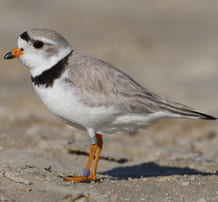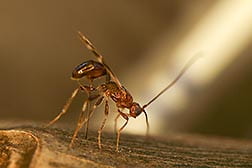Here we are going to talk about a vulnerable bird species that is currently endangered in the Great Lakes region and used to be native to Ohio, the North American Piping Plover (Charadrius melodus).

An adult Piping Plover with blue and red marking tags. The tags are used to help wildlife conservationists track the migration habits of the bird.1 Image courtesy of the Ohio Department of Natural Resources.
What is the Piping Plover?
The species are small shorebirds that reside on the coastal and lakeside beaches of North America. The bird can be distinguished by its distinct sandy brown plumage which allows it to blend perfectly with the sandy beach habitats in which they call home. Adults possess yellow-oranges legs, on their foreheads lies a black band that stretches from eye to eye, and an accompanying black stripe across their chest line.1 They construct shallow nests that are then lined with pebbles and shells from the surrounding area. Females lay four eggs and both sexes have the responsibility of incubation for a 25-41 day period before the eggs hatch.1 The young are then able to walk within hours and fledge (gain their feathers) approximately 20-32 days after hatching.2 The plovers diet mainly consists of insects, beetles, marine worms, small crustaceans, and fly larvae.
The Piping Plover are named after their unique call, which is reminiscent of a two-noted bell-like whistle.4
Typically, plovers breed in the shorelines of the Great Lakes, Northern Great Plains rivers & lakes, and the Atlantic Coast during spring and summer then move to southern areas such as the Gulf of Mexico for the winter months.2 The Piping Plover used to have a native presence in Ohio, specifically, nesting and breeding on the beaches of the Great Lake Erie. However, due to anthropogenic disturbances, destruction of habitats, and other environmental stressors, the species has since ceased to be an Ohio breeder as their nesting range continued to decrease. In fact, according to the Ohio Division of Natural Resources’ Division of Wildlife, the last nesting record of Piping Plover in Ohio was in 1942; they have since transitioned into a migratory species only.1
Why Are They Endangered?
The two primary reasons for the current endangerment status of the Piping Plover are the degradation of their habitats and disturbance of nesting sites.
The habitat loss is primarily caused by the commercial, residential, and recreational developments done by humans on coastal beaches along with global warming which have negatively impacted the surrounding environmental area.2 The construction of water control structures such as dams, while useful for generating renewable energy and reservoir creation, creates major issues for the plovers living lakeside and further inland on river banks. If it were to rain too much, the plover’s nests could potentially flood over. If it gets too hot during warmer seasons, vegetation will start to grow, which will discourage plover’s from nesting as they prefer a flat, sandy habitat devoid of any sort of plant growth that could hide predators.2

Piping Plover eggs strongly resemble regular stones on the beach in both size & color.5 Image courtesy of Christopher Haxter.
The disturbance of nesting sites is caused through either the direct or indirect consumption of the beach by humans. Piping plovers are sensitive to the presence of humans and will abandon their nests if their is too much human activity present in the area. Beach goers, either through casually strolling along the beach or some other activity, may end up accidentally crushing eggs in nests or injure young hatchlings.2 Not just humans can harm the birds, the domesticated pets they bring with them such as cats and dogs often harass and kill the birds. However, not all the blame can be placed on humans; the plover’s natural predators such as foxes, crows, and seagulls feed on unprotected eggs and young, driving the plovers out as well.2
What Is Currently Being Done To Save Them?
The key reason for the continued threat to the Piping plover population is simply lack of awareness of the problem and measures have been put into place by federal organizations such as the U.S. Fish and Wildlife Service to develop recovery plans and regulate human activity in plover-inhabited areas.
Several cooperating research groups are collecting data to determine where plovers breed, estimate population size, and to monitor long-term population fluctuations.2
The regulation of human activity is done thorugh restriction of human access to nesting sites, the monitoring and protection of nesting sites, limiting any human development whether residential or industrial, and managing water flow from dams.
To educate the public in order to increase awareness of the plover’s situation, agencies are running successful public information campaigns that include providing information to coastal beach residents of plover nesting sites about the endangerment status of the bird.2
What Can I Do To Help Save the Piping Plover?
You can do your part to protect the Piping Plover from disappearing from this world by doing these three things:
1) Make yourself better informed about the threats facing the plover’s continuing existence through online research or contacting your local wildlife agencies.2,3
2) Become part of the conservation effort by joining a local chapter of a wildlife management group or just being a volunteer at nature centers or sanctuaries.3
3) Ensure that plover habitats are protected from human activity by staying on boardwalks or trails. If bringing along your pets make sure that they are properly constrained so that they do not end up attacking vulnerable young birds or harming eggs. If deciding to explore off-trail please exercise extreme caution and see if the beach is known to have plover nesting sites.2, 5
Sources:
1. Ohio Department of Natural Resources Division of Wildlife. (n.d.). “Piping Plover-Charadrius melodus.” Retrieved from http://wildlife.ohiodnr.gov/species-and-habitats/species-guide-index/birds/piping-plover
2. U.S. Fish & Wildlife Service. (2001, August). “Piping Plover Fact Sheet.” Retrieved from https://www.fws.gov/Midwest/endangered/pipingplover/pipingpl.html
3. U.S. Fish & Wildlife Service. (2013, October 25) “Piping Plover in the Great Lakes” Retrieved June 12, 2019, from https://m.youtube.com/watch?v=PG1wcOckawU
4. American Bird Conservancy. (2015, April 03). “Piping Plover Calls” Retrieved June 12, 2019, from https://www.youtube.com/watch?time_continue=24&v=I_2un6v_Adw
5. Haxter, C. (2011, August 03). “The Great Piping Plover Nest Search.” Retrieved from http://www.conservewildlifenj.org/blog/2011/08/01/the-great-piping-plover-nest-search/











